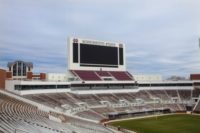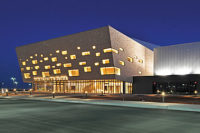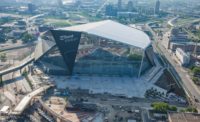Levi’s Stadium in Santa Clara, Calif. recently premiered in August 2014 and is poised to serve as one of the world’s best outdoor sports and entertainment venues. Replacing the antiquated Candlestick Park, the “next generation” stadium will be the new home of the San Francisco 49ers and is also functionally designed for use for a wide range of events including; college football, soccer, motocross, concerts and civic events.
Construction, which began in April 2012, of the state-of-the-art $1.2 billion venue spanned 1.85 million square feet to seat approximately 68,500, and features approximately 165 luxury suites and 8,500 club seats.
Designed by infrastructure solutions firm HNTB Corporation (Kansas City, MO) and built by Turner/Devcon (Santa Clara, Calif.) for the Santa Clara Stadium Authority, the new stadium is designed to be light, airy, and open. The attractive white, painted steel structure of the stadium will also create a unique viewing experience. With the exposed steel, special attention was given to carefully fit all stadium systems within the alignments of the structure to keep the aesthetic clean.
Architectural and structural precast building systems leader, Clark Pacific (Woodland, Calif.), was chosen to produce the precast concrete for the project and recognized the daunting task of achieving these aesthetic goals within the parameters of the 40 million lbs. of their precast concrete involved in the project.
The new 49ers stadium features 2,000 precast panels (risers, walls); with each concrete panel ranging from 20 to 40 feet in length and weighing up to 35,000 pounds—a bit heavier than an average school bus.
To achieve the Levi’s Stadium “Field of Jeans” concrete aesthetic, Clark Pacific enlisted one of the industry’s most trusted names in the manufacturing of site cast, precast, and architectural concrete release agents, Cresset Chemical Company (Weston, Ohio) and their advanced Crete-Lease 880-VOC-Xtra Release Agent.
An environmentally friendly version of the industry staple Crete-Lease 880—The Original, the proprietary blend is comprised of neutralized vegetable oils in mineral oil that contains no waxes, silicones, or carcinogens; it’s also solventless and non-toxic. Notably, this advanced composition exceeds Federal, OTC State, and California State (250 g/L) VOC Regulations.
LEVI’S STADIUM SPECS
Clark Pacific began concrete precasting at their Woodland plant in April of 2012 and finished May of 2013. Approximately 4,000 gallons of Crete-Lease 880-VOC-Xtra were used in the process to provide easy and stain-free clean stripping of all of the stadium’s forms and formliners from concrete. These included stadium forms for panels for the field, lower, mid, and upper levels of the stadium (single, double, and triple risers), and all vomitory wall forms—an integral part of a stadium’s viewing aesthetic. The end result mimicked the form surface and site amenities with a superior finish for visually stunning concrete surfaces—without bugholes.
According to Clark Pacific’s Assistant Plant Manager for the Woodland facility, Ryan Nakken, “We specifically chose Crete-Lease 880-VOC-Xtra because it is safe to handle and use, cleans up well, is easy to apply, and provides consistent results.” Nakken also noted that cost savings are, “Simply built into the process because our panels release from the forms easily, the forms stay clean, and the panel finish is not affected.”
Cresset Chemical’s President, Mike Baty, confirmed the product’s cost-efficiency benefit stating, “When applied properly, it eliminates concrete build-up—cutting labor costs of form cleaning time up to 70 percent.”
Additionally, the release agent strips clean and promotes longer form life by keeping the form clean and accommodating easier stripping. Green technology enhancements also allows for storage of higher quantities, while helping producers simplify DOT driver/HazMat regulations, and eliminates the need for HazMat CDL endorsements.
LEVI’S STADIUM APPLICATION
Crete-Lease 880-VOC-Xtra comes ready to use and can be applied in minutes, hours, days, or up to two weeks before the concrete is placed. Clark Pacific personnel used backpack sprayers for application to the formwork leveraging 0.067 gallons per minute at 40 psi.
To achieve optimal results, form surfaces had to be clean and dry before spraying. An ultra-thin film (0.0005 inches thick) was applied to get a CCS1 finish that promoted easier stripping, less form clean-up and the complete elimination of discoloration, dusting, bugholes, and concrete build-up.
After spraying in a fine mist, workers simply wiped them down evenly with a damp rag with the release agent. If puddles would form, they simply wiped them off.
Additionally, regular use of the product keeps forms clean when used on non-pourous forms and formliners made of plastic (ABS and PVC), elastomeric (urethane and silicone rubber), steel, high density plywood, and medium density plywood overlays. It will not stain or stick from heat curing, and doesn’t interfere with adhesion of caulk, architectural coatings, paint, sealers, and curing compounds on cured concrete surfaces.
LEVI’S STADIUM CONCLUSION
The Levi’s Stadium construction project also boasted a unique “Green-Focused” philosophy with an eye towards sustainability as the stadium incorporates photovoltaic panels, a green roof, water-conserving plumbing systems, sophisticated building control systems, and recycled materials. In fact, Levi’s Stadium is the first new professional football stadium to score LEED Gold status. The newly completed stadium has also been selected as the site for Super Bowl 50.
Ultimately, Cresset Chemical provided a synergistic solution in keeping with these goals with its Chemistry “Green” technology line of products. The product exceeds environmental regulations, while offering concrete producers and architects a myriad of integrated solutions to match specific job application challenges such as: high visual impact, longer form life, easy stripping, non-staining, bughole-free surfaces, reduced clean-up time, no bonding interference, and extreme temperature application amongst others.
Finally, the intent of regulating VOCs is to reduce the amount of ozone (O3) produced at ground level. From the EPA’s point of view, manufacturers of form release agents are responsible for meeting the VOC criteria. While the standard allowable amount of VOCs is 450 g/L, more stringent standards are emerging in states such as California—which requires a 250 g/L standard.
Crete-Lease 880-VOC-Xtra exceeds that requirement at 240 g/L. Today’s high-impact concrete jobs demand using the right release agent—The product is relied upon as one of the best release agents in the industry. Because it uses high-end virgin materials, it naturally performs better as a release agent to consistently deliver a superiorly pleasing aesthetic result.
The product is available in the U.S. and Canada in 1 and 5 gallon containers, Cresset’s familiar 55 gallon orange and white striped drums, and 275 gallon MegaPaks. Shipping options are designed for reconditioning to save on disposal costs, are not federally regulated, and do not require following hazardous shipping requirements. Cresset also offers a limited warranty against defects in materials for a period of 1 year from purchase.
For more detailed information, visit www.cresset.com.







Report Abusive Comment